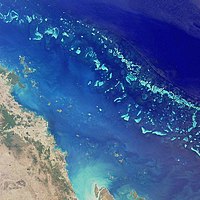
Photo from wikipedia
The increased occurrence of extreme climate events, such as marine heatwaves (MHWs), has resulted in substantial ecological impacts worldwide. To date metrics of thermal stress within marine systems have focussed… Click to show full abstract
The increased occurrence of extreme climate events, such as marine heatwaves (MHWs), has resulted in substantial ecological impacts worldwide. To date metrics of thermal stress within marine systems have focussed on coral communities, and less is known about measuring stress relevant to other primary producers, such as seagrasses. An extreme MHW occurred across the Western Australian coastline in the austral summer of 2010/2011, exposing marine communities to summer seawater temperatures 2-5 °C warmer than average. Using a combination of satellite imagery and in situ assessments, we provide detailed maps of seagrass coverage across the entire Shark Bay World Heritage Area (ca. 13,000 km2 ) before (2002, 2010) and after the MHW (2014, 2016). Our temporal analysis of these maps documents the single largest loss in dense seagrass extent globally (1,310 km2 ) following an acute disturbance. Total change in seagrass extent was spatially heterogenous, with the most extensive declines occurring in the Western Gulf, Wooramel Bank and Faure Sill. Spatial variation in seagrass loss was best explained by a model that included an interaction between two heat stress metrics, the most substantial loss occurring when degree heat weeks (DHWm) was ≥ 10 and the number of days exposed to extreme sea surface temperature during the MHW (DaysOver) was ≥ 94. Ground-truthing at 622 points indicated that change in seagrass cover was predominantly due to loss of Amphibolis antarctica rather than Posidonia australis, the other prominent seagrass at Shark Bay. As seawater temperatures continue to rise and the incidence of MHWs increase globally, this work will provide a basis for identifying areas of meadow degradation, or stability and recovery; and potential areas of resilience.
Journal Title: Global change biology
Year Published: 2020
Link to full text (if available)
Share on Social Media: Sign Up to like & get
recommendations!